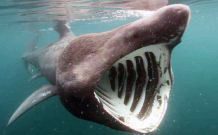DIVING NEWS
New light on baskers’ ups and downs

Picture: P Docherty.
Basking sharks move to different depths according to the season as well as the time of day, according to a new study of the animals in Scottish waters by UK researchers.
Behaviour patterns of the world’s second-largest shark species have long been a mystery, but the scientists say they have established for the first time that the sharks spend most of the summer months at the ocean’s surface and dive deeper in winter.
They believe that they could be exploring different parts of the ocean to deal with changes in food abundance.
Towards late winter and early spring, basking sharks were also found to perform “yo-yo dives” – rapid repeated transitions between deep and shallow waters. Several of the sharks studied would dive to more than 1000m, and two were tracked as deep as 1500m.
“They may be sampling the water column in efforts to detect prey, or attempting to re-orientate themselves for navigation purposes,” said lead author of the study Dr Phil Doherty from the University of Exeter.
His team worked with Scottish Natural Heritage, MarAlliance, Manx Basking Shark Watch and Wave Action to monitor the movements of 32 satellite-tagged basking sharks.
The tags gathered data on depth, temperature and ambient light levels.
“We found that sharks spent most of the summer near the surface of the water, occupying the top few metres during the day, moving down to depths of 10-25m at night,” said Dr Doherty. Such “reverse diel vertical migration” had previously been observed in other big plankton-eaters the whale and megamouth sharks.
30 September 2019
Dr Doherty said that in winter the basking sharks “did the opposite, spending the majority of time between 50 and 250m, but more often shallower during the night”. Plankton tends to remain near the surface in summer months, but to move deeper in winter.
The researchers hope to use the study to help identify “depth hotspots” of basking-shark activity.
The sharks are considered a “threatened” species and the north-east Atlantic population “endangered”, so understanding their diving behaviour and preferred depths could help reduce the risk of bycatch by commercial fisheries, and inform conservation measures.
